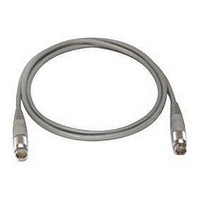11730D AGILENT TECHNOLOGIES, 11730D Datasheet - Page 63

11730D
Manufacturer Part Number
11730D
Description
SENSOR CABLE, 50FT
Manufacturer
AGILENT TECHNOLOGIES
Datasheet
1.11730D.pdf
(234 pages)
Specifications of 11730D
Leaded Process Compatible
No
Peak Reflow Compatible (260 C)
No
Cable Length
50ft
Features
Reduces RFI Effect On Low Power Readings With Improved Shielding Design
Cable Assembly Type
Sensor
Cable Color
Gray
Rohs Compliant
No
For Use With
8480 & E-Series Power Sensors
Lead Free Status / RoHS Status
Contains lead / RoHS non-compliant
- Current page: 63 of 234
- Download datasheet (7Mb)
52
8
Detectors
Detectors
Applications
Agilent Technologies broadband detectors
100 kHz to 50 GHz. These detectors are widely used on the design
and production test bench, as well as for internal components of
test system signal interface units. They find use in a variety of test
and measurement applications.
• Power monitoring
• Source leveling
• Video detection
• Swept transmission and reflection measurements
Technology
Agilent detectors are available in two families – Silicon Low
Barrier Schottky Diode (LBSD) and Gallium Arsenide Planar Doped
Barrier Diode (GaAs PDBD) detectors. The Gallium Arsenide
detector technology produces diodes with extremely flat frequency
response to 50 GHz. Also, the GaAs PDBD detector has a wider
operating temperature range (–65 °C to +100 °C), and is less
sensitive to temperature changes.
Key specifications
• Frequency range
• Frequency response
• Open circuit voltage sensitivity
• Tangential sensitivity
• Output voltage versus temperature
• Rise time
• SWR
• Square-law response
• Input power
Frequency range
Frequency range can be one of the most important factors to
consider when specifying detectors. In the past, broadband
frequency coverage was equated with high performance. It is
important to note that though broadband coverage may be
desirable in multi-octave applications, a good octave range
detector may be your best solution for non-swept applications.
Broadband coverage saves you from the inconvenience of having
to switch between detectors when making measurements, but you
may be sacrificing SWR and frequency response flatness. All of
Agilent’s 8474 family of coaxial detectors are available in both
octave band and broadband versions. The guaranteed
performance of the octave band models are characterized for
frequency response flatness and SWR.
1
See Waveguide chapter for additional products.
1
span frequencies from
Frequency response
Frequency response is the variation in output voltage versus
frequency, with a constant input power. Frequency response is
referenced to the lowest frequency of the band specified. Agilent
typically uses –30 dBm to measure frequency response. Agilent
uses precision thin-film input circuitry to provide good, broadband
input matching. Exceptionally flat frequency response is provided
by the very low internal capacitance of the PDB diode. Also,
excellent control of the video resistance of the PDB diode is
obtained by the precision growth of molecular beam epitaxy
(MBE) layers during diode fabrication.
Figure 1 displays frequency response characteristics comparing
Agilent LBSD and PDBD detectors. The figure indicates typical
performance of each device and the published specifications.
Frequency response specifications include the mismatch effects of
the detector input SWR specifications. Note that the Agilent
8474E, representative of PDBD detectors, is exceptionally flat
beyond 26.5 GHz.
–1
–2
Figure 1. Detector frequency response characteristics.
0
2
1
Frequency response (dB)
0
Agilent 8473B,C LBSD
Typical guaranteed
12.4
18
Frequency (GHz)
26.5
33
Agilent 8474E PDBD
Typical guaranteed
40
50
Related parts for 11730D
Image
Part Number
Description
Manufacturer
Datasheet
Request
R

Part Number:
Description:
Agilent Tachyon DX4+ (HPFC-5700) Dual-Channel 4-Gb Fibre Channel Controller With The Data Integrity Field (DIF) Feature
Manufacturer:
Agilent Technologies, Inc.

Part Number:
Description:
Manufacturer:
Agilent Technologies, Inc.
Datasheet:

Part Number:
Description:
Manufacturer:
Agilent Technologies, Inc.
Datasheet:

Part Number:
Description:
Manufacturer:
Agilent Technologies, Inc.
Datasheet:

Part Number:
Description:
Manufacturer:
Agilent Technologies, Inc.
Datasheet:

Part Number:
Description:
Manufacturer:
Agilent Technologies, Inc.
Datasheet:

Part Number:
Description:
Manufacturer:
Agilent Technologies, Inc.
Datasheet:

Part Number:
Description:
Manufacturer:
Agilent Technologies, Inc.
Datasheet:

Part Number:
Description:
Manufacturer:
Agilent Technologies, Inc.
Datasheet:

Part Number:
Description:
Manufacturer:
Agilent Technologies, Inc.
Datasheet:

Part Number:
Description:
Manufacturer:
Agilent Technologies, Inc.
Datasheet:

Part Number:
Description:
Manufacturer:
Agilent Technologies, Inc.
Datasheet:

Part Number:
Description:
1.0625 GBd Fibre Channel 10x10 mm QFP Transceiver Chip (Recommend HDMP-1636A for new designs)
Manufacturer:
Agilent Technologies, Inc.
Datasheet:

Part Number:
Description:
Manufacturer:
Agilent Technologies, Inc.
Datasheet:

Part Number:
Description:
1.0625-2.125 GBd Serdes Circuits: SSTL_2
Manufacturer:
Agilent Technologies, Inc.
Datasheet:










